Drones and AI can save lives at sea

The question is not whether but how drones can be used to save lives at sea. A project funded by the Swedish Transport Administration has delved into how AI technology can assist in locating distressed individuals more quickly, improving situational awareness, and enhancing the safety of all involved.
Using drones in search and rescue operations is not new. Several authorities and emergency response organizations have shown interest in the technology, and in 2022, the Swedish Sea Rescue Society received the country's first permit to fly and test drones beyond visual line of sight in the Gothenburg archipelago. Drones can provide real-time imagery of an incident shortly after an alert is received, with the aim of making maritime rescue operations both more efficient and safer.
However, the question remains: how is this best achieved? Can AI technology help? This is precisely what the SAR UAS demonstration project has explored.
"The overarching goal is to locate and rescue individuals faster and save more lives. At the same time, we also want to increase the safety of participants in the rescue operation, save costs through fuel savings and cheaper technology, and reduce environmental impact. For example, a drone consumes much less fuel than a helicopter," says Lisa Berlin of the Swedish Maritime Administration, who led the project.
The project has focused on the technology itself, its applicability in a search and rescue system. Several types of drones and AI models have been evaluated, along with examining how the technology can be improved to be more user-friendly and effective.
"We have evaluated algorithms and their ability to identify distressed individuals. There are, of course, many other objects that could be used to make search operations more efficient, such as oars or other items that deviate in the water. However, it is a comprehensive task to investigate AI models, and we had limited time."
To make it as similar to a real case as possible, tests were conducted with two different scenarios based on historical data from previous maritime and aviation rescue operations. So how well does the technology work? Is the research favorable?
"When it comes to technology, there is a lot of progress. You can essentially get what you want as long as you pay for it. Otherwise, there are some challenges. One of the biggest challenges is the legal aspect. It is not allowed to fly drones everywhere, and for example, accidentally filming areas with higher security classifications. It is a challenge to align technology with the law. Other challenges include representative data, drone weather capabilities, and system usability," says Lisa Berlin.
The project's final report recommends the development of two different systems. The first is a smaller type of drone system, similar to those already used by some rescue organizations but enhanced with AI technology. This system, referred to as a local UAS (Unmanned Aircraft System) in the report, has a limited range and is best suited for use near the coast or within a short distance from where the operator is located.
The second system has a longer range and can cover a large part of the Swedish rescue region from a few bases. This system, referred to as a national UAS in the report.
"There are many different technologies and types of drones. Some can be launched and controlled from a vessel. Smaller variants can be thrown, others are so large that they require a helicopter pad, and there are also those that require a runway for takeoff. This project gave us good knowledge of the technologies available and what they can handle technically. But how they perform in real situations, we do not know. Therefore, further research and development are required to systematically explore how we can use the technology," says Lisa Berlin.
However, she is convinced that AI technology can help us save lives at sea.
"Imagine searching for distressed individuals by looking at and analyzing images on a screen for hours. The advantage of AI is that it works quickly and can handle large amounts of data without ever getting tired."
-
 2025 – ett år präglat av osäkerhet
2025 – ett år präglat av osäkerhet -
 "Ögon på plats” tidigt kan rädda liv
"Ögon på plats” tidigt kan rädda liv -
 Antifoulingfärger testas bäst i strömmande vatten
Antifoulingfärger testas bäst i strömmande vatten -
 Så kan biogasen få en betydande roll för sjöfartens omställning
Så kan biogasen få en betydande roll för sjöfartens omställning -
 Från motorbåt till militärfartyg – traineeprogrammet gav Isak nycklarna till sjöfartsbranschen
Från motorbåt till militärfartyg – traineeprogrammet gav Isak nycklarna till sjöfartsbranschen -
 DNV: Metanol är ett moget alternativt bränsle
DNV: Metanol är ett moget alternativt bränsle -
 Se Hållbar sjöfarts uppsamlingsheat
Se Hållbar sjöfarts uppsamlingsheat -
 NextWave – en podd som ska locka unga
NextWave – en podd som ska locka unga -
 Ny studie: Eldrivna pendelbåtar kan effektivisera Stockholms kollektivtrafik
Ny studie: Eldrivna pendelbåtar kan effektivisera Stockholms kollektivtrafik -
 Sjöfartens utsläpp ökar
Sjöfartens utsläpp ökar

